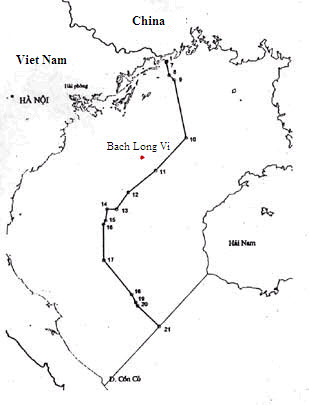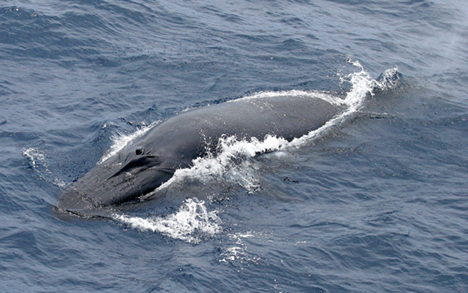|
Xieyang Island
Xieyang Island () is a Chinese island in the Gulf of Tonkin, located south-east of Weizhou Island. Administratively it, along with Weizhou Island, forms the town of Weizhou, Guangxi, Weizhou, in Haicheng District, Beihai, Guangxi. It is one of the tourist attractions of Beihai. Geography Xieyang has an area of only and is of volcanic origin. The island may be described as appearing like a goat with its front legs crouched, and so in ancient times was called "". Environment Along with Weizhou , waters around Xieyang were discovered in 2015 to be seasonally frequented by Bryde's whales, and the area has become the first acknowledged location among mainland coasts of China to have regular migrations of large cetaceans.Bingyao Chen, Lin Zhu, Thomas A. Jefferson, Kaiya Zhou, Guang Yang, 2019, ''Coastal Bryde's Whales' (Balaenoptera edeni) Foraging Area Near Weizhou Island in the Beibu Gulf'', Aquatic Mammals, Vol.45, Issue 3 Xieyang, along with nearby Weizhou, has been designated a ... [...More Info...] [...Related Items...] OR: [Wikipedia] [Google] [Baidu] |
Guangxi
Guangxi,; officially the Guangxi Zhuang Autonomous Region, is an Autonomous regions of China, autonomous region of the China, People's Republic of China, located in South China and bordering Vietnam (Hà Giang Province, Hà Giang, Cao Bằng Province, Cao Bằng, Lạng Sơn Province, Lạng Sơn, and Quảng Ninh Provinces) and the Gulf of Tonkin. Formerly a Provinces of China, province, Guangxi became an autonomous region in 1958. Its current capital is Nanning. Guangxi's location, in mountainous terrain in the far south of China, has placed it on the frontier of Chinese civilization throughout much of History of China, Chinese history. The current name "Guang" means "expanse" and has been associated with the region since the creation of Guang Prefecture in 226 AD. It was given Administrative divisions of the Yuan dynasty, provincial level status during the Yuan dynasty, but even into the 20th century, it was considered an open, wild territory. The abbreviation of the regi ... [...More Info...] [...Related Items...] OR: [Wikipedia] [Google] [Baidu] |
Beihai
Beihai (; Postal romanization: Pakhoi) is a prefecture-level city in the south of Guangxi, People's Republic of China. Its status as a seaport on the north shore of the Gulf of Tonkin has granted it historical importance as a port of international trade for Guangxi, Hunan, Hubei, Sichuan, Guizhou, and Yunnan. Between the years 2006 and 2020, Beihai was predicted to be the world's fastest growing city. Beihai has a large shipyard, but most of the money generated in the city is derived from trade. In addition, it governs the small islands of Weizhou and Xieyang, and is directly west of Leizhou Peninsula. Subdivisions Up to 2022, Beihai contains 3 districts and 1 county, which are subdivided into 7 urban sub-districts, 22 towns, 1 townships, 95 neighborhood committees, 336 village committees. (see also Administrative divisions of the People's Republic of China#Levels) * Haicheng District () * Yinhai District () * Tieshangang District () * Hepu County () History Af ... [...More Info...] [...Related Items...] OR: [Wikipedia] [Google] [Baidu] |
Haicheng District
Haicheng (; ) is the seat of the city of Beihai, Guangxi, China. It has an area of and a population of 240,000 . Administrative divisions Haicheng District is divided into 7 subdistricts and 1 town: Subdistricts: * Zhongjie Subdistrict (中街街道), Dongjie Subdistrict (东街街道), Xijie Subdistrict (西街街道), Haijiao Subdistrict (海角街道), Dijiao Subdistrict (地角街道), Gaode Subdistrict (高德街道), Yima Subdistrict (驿马街道) The only town is Weizhou (涠洲镇) See also * List of administrative divisions of Guangxi References External links Official website (in Simplified Chinese Simplification, Simplify, or Simplified may refer to: Mathematics Simplification is the process of replacing a mathematical expression by an equivalent one that is simpler (usually shorter), according to a well-founded ordering. Examples include: ...) County-level divisions of Guangxi Beihai {{Guangxi-geo-stub ... [...More Info...] [...Related Items...] OR: [Wikipedia] [Google] [Baidu] |
Weizhou, Guangxi
Weizhou () is a town of Haicheng District, Beihai, Guangxi, People's Republic of China. The town comprises two Gulf of Tonkin islands: Weizhou Island and a smaller Xieyang Island (斜阳岛), covering an area of and with a population of 15,900. It includes 2 neighborhood committees, 9 village committees. , it has 2 residential communities (社区) and 9 villages under its administration. See also * List of township-level divisions of Guangxi This is a list of township-level divisions of Guangxi Zhuang Autonomous Region, People's Republic of China (PRC). After province, prefecture, and county-level divisions, township-level divisions constitute the formal fourth-level administrati ... References Towns of Guangxi Beihai {{Guangxi-geo-stub ... [...More Info...] [...Related Items...] OR: [Wikipedia] [Google] [Baidu] |
Island
An island or isle is a piece of land, distinct from a continent, completely surrounded by water. There are continental islands, which were formed by being split from a continent by plate tectonics, and oceanic islands, which have never been part of a continent. Oceanic islands can be formed from volcano, volcanic activity, grow into atolls from coral reefs, and form from sediment along shorelines, creating barrier islands. River islands can also form from sediment and debris in rivers. Artificial islands are those made by humans, including small rocky outcroppings built out of lagoons and large-scale land reclamation projects used for development. Islands are host to diverse plant and animal life. Oceanic islands have the sea as a natural barrier to the introduction of new species, causing the species that do reach the island to evolve in isolation. Continental islands share animal and plant life with the continent they split from. Depending on how long ago the continental is ... [...More Info...] [...Related Items...] OR: [Wikipedia] [Google] [Baidu] |
Gulf Of Tonkin
The Gulf of Tonkin is a gulf at the northwestern portion of the South China Sea, located off the coasts of Tonkin ( northern Vietnam) and South China. It has a total surface area of . It is defined in the west and northwest by the northern coastline of Vietnam down to the Cồn Cỏ district, in the north by China's Guangxi Zhuang Autonomous Region, and to the east by the Leizhou Peninsula and Hainan Island. English sources from the People's Republic of China refer to the Gulf of Tonkin as Beibu Wan. Description and etymology The name ''Tonkin'', written "" in chữ Hán characters and in the Vietnamese alphabet, means "eastern capital", and is the former toponym for Hanoi, the present capital of Vietnam. It is not to be confused with Tokyo, which is also written "" and also means "eastern capital". During the French colonial era, the northern region of today’s Vietnam was called ''Tonkin''. ''Bắc Bộ'' is the native Vietnamese name of Tonkin, which is the nowad ... [...More Info...] [...Related Items...] OR: [Wikipedia] [Google] [Baidu] |
Weizhou Island
Weizhou Island () is a Chinese island in Beibu Gulf in the Gulf of Tonkin. The largest island of Guangxi Zhuang Autonomous Region, Weizhou is west of Leizhou Peninsula, south of Beihai, and east of Vietnam. Administratively, it is part of Weizhou Town, Haicheng District of Beihai City. The name derives from Chinese 潿 ''wéi'' ("still water") and 洲 ''zhōu'' ("river islet"). Geography Its north–south length is , east–west . The coast is , with of sandy beach. Weizhou rises in the south, where Nanwan Port (南灣港; pinyin: nánwān gǎng) is located. Coral reefs have been established around the island. Climate Geology Weizhou Island is China's youngest volcanic island. Its origin is probably from a mantle plume that rose 50–32 million years ago, as a result from the collision of the Indian and Eurasian plates. When the plume reached the asthenosphere, it helped to create the South China Sea by the plume's lateral flow. An evidence that the plume still exis ... [...More Info...] [...Related Items...] OR: [Wikipedia] [Google] [Baidu] |
Bryde's Whale
Bryde's whale ( ), or the Bryde's whale complex, putatively comprises three species of rorqual and possibly four. The "complex" means the number and classification remain unclear because of a lack of definitive information and research. The common Bryde's whale (''Balaenoptera brydei'', Olsen, 1913) is a larger form that occurs worldwide in warm temperate and tropical waters, and the Sittang or Eden's whale (''Balaenoptera edeni'', Anderson, 1879) is a smaller form that may be restricted to the Indo-Pacific. Also, a smaller, coastal form of ''B. brydei'' is found off southern Africa, and perhaps another form in the Indo-Pacific differs in skull morphology, tentatively referred to as the Indo-Pacific Bryde's whale. The recently described Omura's whale (''B. omurai'', Wada et al. 2003), was formerly thought to be a pygmy form of Bryde's, but is now recognized as a distinct species. Rice's whale (''B. ricei''), which makes its home solely in the Gulf of Mexico, was once consider ... [...More Info...] [...Related Items...] OR: [Wikipedia] [Google] [Baidu] |
Important Bird Area
An Important Bird and Biodiversity Area (IBA) is an area identified using an internationally agreed set of criteria as being globally important for the conservation of bird populations. IBA was developed and sites are identified by BirdLife International. There are over 13,000 IBAs worldwide. These sites are small enough to be entirely conserved and differ in their character, habitat or ornithological importance from the surrounding habitat. In the United States the program is administered by the National Audubon Society. Often IBAs form part of a country's existing protected area network, and so are protected under national legislation. Legal recognition and protection of IBAs that are not within existing protected areas varies within different countries. Some countries have a National IBA Conservation Strategy, whereas in others protection is completely lacking. History In 1985, following a specific request from the European Economic Community, Birdlife International dr ... [...More Info...] [...Related Items...] OR: [Wikipedia] [Google] [Baidu] |
BirdLife International
BirdLife International is a global partnership of non-governmental organizations that strives to conserve birds and their habitats. BirdLife International's priorities include preventing extinction of bird species, identifying and safeguarding important sites for birds, maintaining and restoring key bird habitats, and empowering conservationists worldwide. It has a membership of more than 2.5 million people across List of BirdLife International national partner organisations, 116 country partner organizations, including the Royal Society for the Protection of Birds, the Wild Bird Society of Japan, the National Audubon Society, and American Bird Conservancy. BirdLife International has identified 13,000 Important Bird Area, Important Bird and Biodiversity Areas and is the official International Union for Conservation of Nature's IUCN Red List, Red List authority for birds. BirdLife International has established that 1,375 bird species (13% of the total) are threatened with extinc ... [...More Info...] [...Related Items...] OR: [Wikipedia] [Google] [Baidu] |
Chinese Egret
The Chinese egret or Swinhoe's egret (''Egretta eulophotes'') is a threatened species of egret from east Asia, first described by Robert Swinhoe in 1860. Description The Chinese egret averages 68 cm in height. The plumage is white throughout the bird's life and resembles the little egret (''Egretta garzetta''). Outside the breeding season the bill is dusky with the basal portion being tannish peach and the lores and legs yellow green, while the iris is yellow. All individuals are similar in this season. In the breeding season the adults develop a luxuriant crest which is sometimes over 11 cm long. It also develops long lanceolate plumes on its breast and dorsal plumes extending beyond the tail, called aigrettes and similar to those of little egret. The bare parts change too, the bill becomes a bright, almost orange, yellow while the lores turn bright blue and the legs black with yellow feet. Distribution and population The Chinese egret breeds on small islands off ... [...More Info...] [...Related Items...] OR: [Wikipedia] [Google] [Baidu] |
Fairy Pitta
The fairy pitta (''Pitta nympha'') is a small and brightly colored species of passerine bird in the family Pittidae. Its diet mainly consists of earthworms, spiders, insects, slugs, and snails. The fairy pitta breeds in East Asia and migrates south to winter in Southeast Asia. Due to various habitat and anthropogenic disruptions, such as deforestation, wildfire, hunting, trapping, and cage-bird trade, the fairy pitta is rare and the population is declining in most places. Listed on the Convention on International Trade in Endangered Species of Wild Fauna and Flora (CITES) Appendix II, this bird is classified as vulnerable on the IUCN Red List of Threatened Species. Taxonomy The fairy pitta is one of around 14 species in the genus ''Pitta''. Within the genus, it is most closely related to the hooded pitta, with these two species forming a clade that is sister to the blue-winged pitta. The fairy pitta was first described in 1847. It was formerly considered to be conspecific ... [...More Info...] [...Related Items...] OR: [Wikipedia] [Google] [Baidu] |








